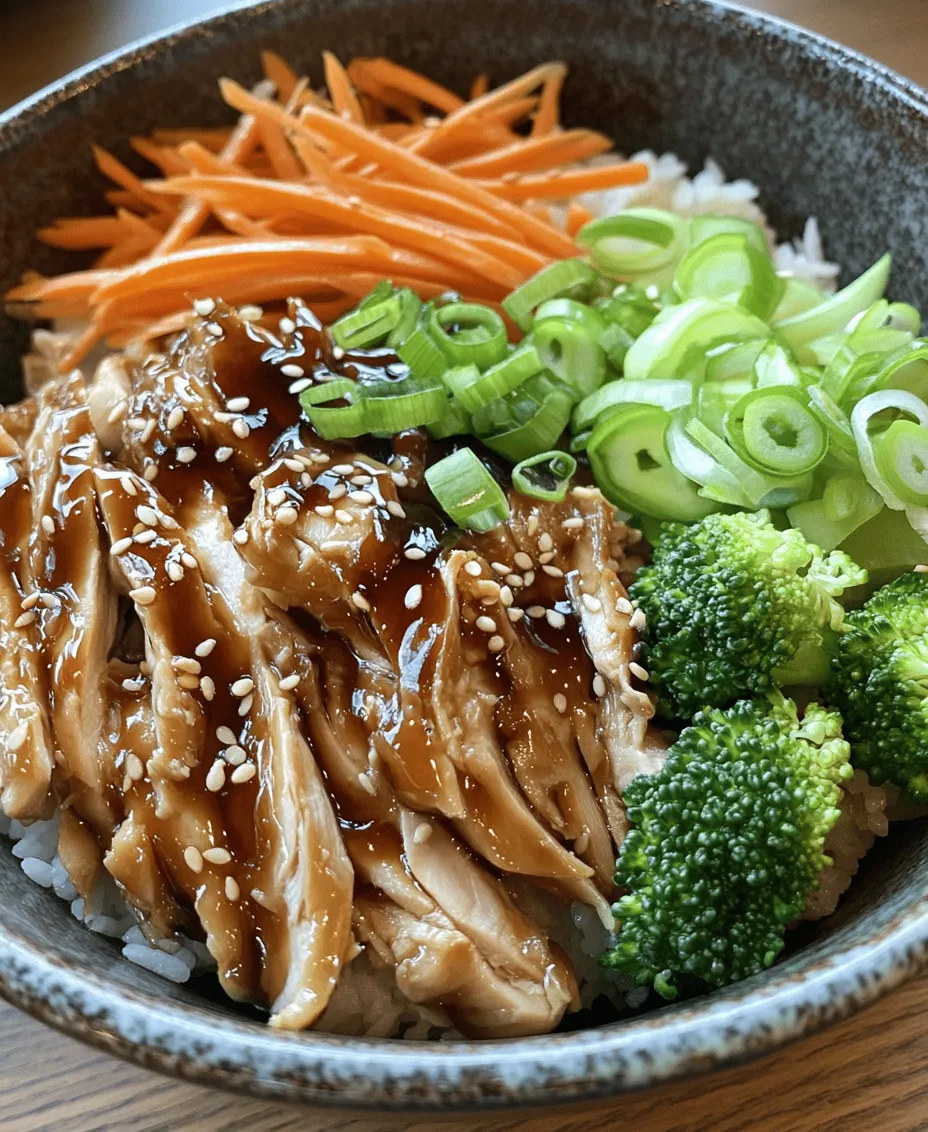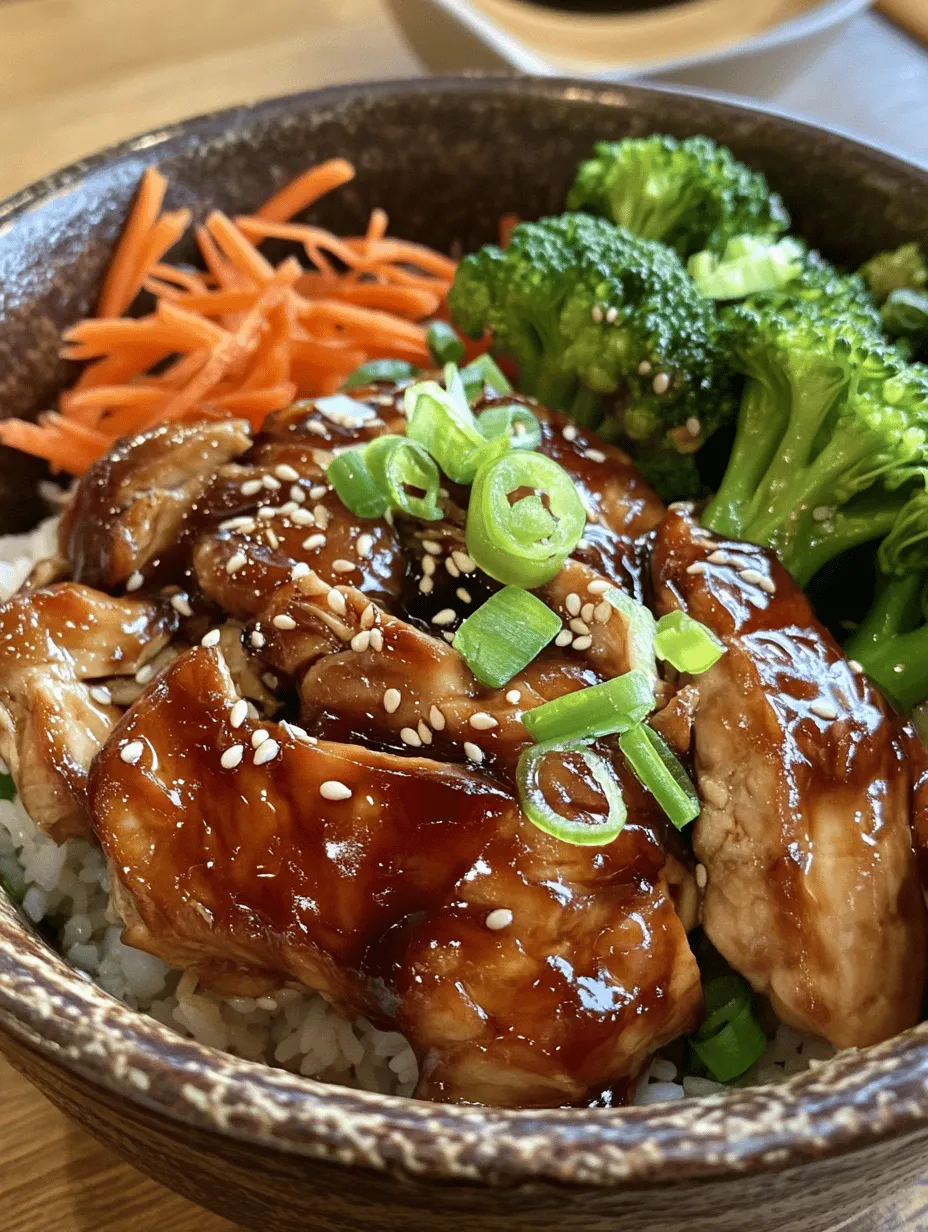Introduction
The Teriyaki Chicken Rice Bowl is a beloved staple within Asian cuisine, celebrated for its delightful fusion of flavors and textures. This dish combines tender chicken glazed in a savory-sweet teriyaki sauce, served over a bed of fluffy rice, and complemented with vibrant vegetables. It has gained popularity not only in restaurants but also in home kitchens, where food enthusiasts seek to replicate its deliciousness. Making this dish at home allows for greater control over the ingredients, particularly when it comes to the teriyaki sauce, which can be crafted to suit one’s personal taste preferences.
One of the most appealing aspects of preparing a Teriyaki Chicken Rice Bowl is the ability to create your own homemade teriyaki sauce. While store-bought options are convenient, they often contain preservatives and added sugars that can detract from the authentic taste. By making teriyaki sauce from scratch, cooks can ensure a perfect balance of soy sauce, sweetness, and acidity, tailoring it to individual preferences. The result is a dish that not only satisfies the palate but also nourishes the body, making it a fantastic choice for family dinners or meal prep.
When you think of a teriyaki chicken rice bowl, imagine the enticing aroma of marinated chicken sizzling in a hot pan, the warmth of jasmine rice, and the crunch of fresh vegetables. Each component contributes to a wholesome meal that is both satisfying and nutritious. As we delve deeper into this recipe, you will discover how to bring this classic dish to your table with ease.
Understanding Teriyaki
To appreciate the Teriyaki Chicken Rice Bowl fully, it’s essential to understand the origins and defining characteristics of teriyaki sauce. The term “teriyaki” comes from the Japanese words “teri,” meaning glaze, and “yaki,” which translates to grilled or broiled. This cooking technique dates back to the 17th century in Japan, where fishermen and merchants would marinate their catch in a mixture of soy sauce, sake, and sugar before grilling it over an open flame. Over time, this method evolved, and teriyaki became a popular way to prepare various meats and vegetables.
Teriyaki sauce is typically composed of key ingredients that harmonize to create its signature flavor. Common components include soy sauce, mirin (a sweet rice wine), sake, and sugar. These ingredients come together to form a rich, glossy glaze that enhances the natural flavors of the protein or vegetables used. The sauce can be used in a variety of dishes, from stir-fries to marinades, showcasing its versatility in the kitchen.
In addition to its traditional uses, teriyaki sauce can be adapted to suit different culinary styles, making it a fantastic base for fusion dishes. Whether you’re incorporating it into tacos or using it as a dressing for salads, teriyaki sauce brings a unique umami flavor that elevates any meal.
Ingredients Breakdown
Creating a Teriyaki Chicken Rice Bowl requires a selection of fresh, high-quality ingredients that come together to create a delightful dish. Let’s take a closer look at each component and its significance:
Chicken Breasts
At the heart of this dish are chicken breasts, known for their lean protein content and versatility. Chicken breasts are a great source of essential nutrients, including protein, niacin, and selenium. They also have a mild flavor that absorbs marinades beautifully, making them ideal for teriyaki preparation. For those looking for alternatives, boneless skinless thighs can also be used, offering a richer taste and juicier texture.
Jasmine Rice
Jasmine rice is the traditional choice for serving with teriyaki, known for its fragrant aroma and fluffy texture. It pairs exceptionally well with the savory sauce. When cooking jasmine rice, it’s essential to rinse it thoroughly before cooking to remove excess starch, which can make the rice gummy. Alternatively, you can use brown rice for a more nutritious option, or even quinoa for a gluten-free twist.
Soy Sauce
Soy sauce is a fundamental ingredient in teriyaki sauce, contributing its distinct salty umami flavor. Various types of soy sauce are available, including light, dark, and low-sodium options. Light soy sauce is often used for dipping and marinades, while dark soy sauce adds a deeper color and sweetness. For those with dietary restrictions, tamari is a gluten-free alternative that can be used interchangeably.
Honey vs. Brown Sugar
When it comes to sweetening the teriyaki sauce, you can choose between honey and brown sugar. Honey offers a floral sweetness and a thicker consistency, while brown sugar provides a more caramel-like flavor. Both options are effective in balancing the saltiness of the soy sauce, though personal preference may dictate which one to use.
Rice Vinegar
Rice vinegar plays a crucial role in balancing the flavors of the teriyaki sauce. It adds a subtle acidity that cuts through the sweetness and saltiness, enhancing the overall taste of the dish. While rice vinegar is the traditional choice, apple cider vinegar can serve as a suitable substitute if needed.
Sesame Oil
Sesame oil adds a nutty flavor and richness to the teriyaki sauce. It can be used in moderation during cooking to impart a delightful aroma and taste. For those who prefer a lighter option, grapeseed or avocado oil can be used instead, though they will alter the dish’s flavor profile slightly.
Garlic and Ginger
Garlic and ginger are classic aromatics that enhance the flavor of the teriyaki sauce. Both ingredients not only add depth but also bring health benefits, including anti-inflammatory properties and immune support. Fresh garlic and ginger are recommended for their potent flavors, but ground versions can be used in a pinch.
Cornstarch
Cornstarch is essential for achieving the desired consistency of the teriyaki sauce. When combined with a little water, it creates a slurry that thickens the sauce as it cooks, giving it a luscious, glossy finish that clings beautifully to the chicken.
Fresh Vegetables
Incorporating fresh vegetables like broccoli and carrots not only adds color and texture to the dish but also boosts its nutritional profile. Broccoli is rich in vitamins C and K, while carrots provide beta-carotene and fiber. You can also experiment with other vegetables such as bell peppers or snap peas for added variety.
Garnishes
Finishing touches like sesame seeds and sliced green onions not only enhance the presentation but also add an extra layer of flavor and crunch. These garnishes can elevate the dish visually and nutritionally, offering a nice contrast to the tender chicken and rice.
Preparation Steps
Before diving into cooking, it’s vital to prepare and organize your ingredients. Meal prep is an essential step in the cooking process, ensuring that everything is within reach and ready to go. Start by gathering all the ingredients and measuring them out, which will streamline the cooking process and make it more enjoyable.
1. Marinate the Chicken: Begin by preparing the teriyaki sauce. In a bowl, whisk together soy sauce, honey (or brown sugar), rice vinegar, sesame oil, minced garlic, and grated ginger. Reserve a portion of the sauce for later use, as you’ll need it for drizzling over the bowl before serving. Marinate the chicken in the remaining sauce for at least 30 minutes, or even overnight for better flavor absorption.
2. Cook the Rice: While the chicken marinates, rinse the jasmine rice under cold water until the water runs clear. This step is crucial for achieving fluffy rice. Then, cook the rice according to package instructions or using a rice cooker. Typically, the ratio is 1 cup of rice to 1.5 cups of water. Allow it to steam once cooked for a few minutes to enhance its texture.
3. Prepare the Vegetables: As the rice cooks, wash and chop your vegetables. Whether you choose to steam, sauté, or stir-fry them, they should be bright and tender-crisp by the time you are ready to assemble the bowl.
4. Cook the Chicken: Heat a non-stick skillet over medium-high heat and add a drizzle of oil. Remove the chicken from the marinade and sear it in the skillet until it’s fully cooked and has a nice golden brown exterior. This usually takes about 6-8 minutes per side, depending on the thickness of the chicken breasts. Once cooked, pour in the reserved teriyaki sauce and let it simmer for a few minutes to thicken.
By following these preparation steps, you’ll create a delectable Teriyaki Chicken Rice Bowl that showcases the beautiful marriage of flavors and textures. Stay tuned for the next part of the article, where we’ll dive into the assembly of this dish, garnishing tips, and additional variations to suit your culinary adventures.

Step-by-Step Detailed Instructions for Teriyaki Chicken Rice Bowl
Creating a delicious Teriyaki Chicken Rice Bowl involves several phases. Below, you will find detailed instructions for each step to ensure your dish is flavorful and visually appealing.
Cooking Jasmine Rice: Techniques for Perfect Texture
1. Rinse the Rice: Begin by measuring 1 cup of jasmine rice. Rinse the rice under cold water in a fine-mesh strainer until the water runs clear. This step removes excess starch and helps prevent the rice from becoming gummy.
2. Cook the Rice: In a medium saucepan, combine the rinsed rice with 1 ¾ cups of water. Add a pinch of salt for flavor. Bring the water to a boil over high heat, then lower the heat to a simmer. Cover the saucepan with a tight-fitting lid and let it cook for about 15 minutes. Avoid lifting the lid during this time, as it will steam the rice.
3. Fluff the Rice: Once the rice has absorbed all the water, remove the saucepan from heat and let it sit, covered, for an additional 10 minutes. This resting period allows the rice to steam and become fluffy. Finally, use a fork to gently fluff the rice before serving.
Preparing Chicken: Tips for Cutting and Marinating
1. Selecting the Chicken: Use boneless, skinless chicken thighs for this recipe, as they are more flavorful and tender compared to chicken breasts. You’ll need about 1 pound of chicken.
2. Cutting the Chicken: Slice the chicken into bite-sized pieces, about 1-inch cubes. Make sure to cut against the grain to ensure tenderness.
3. Marination: In a bowl, combine the chicken pieces with ¼ cup of soy sauce, 2 tablespoons of mirin (sweet rice wine), and 1 tablespoon of honey or brown sugar. Allow the chicken to marinate for at least 30 minutes, but ideally, let it marinate for a few hours in the refrigerator. This step enhances the flavor and tenderness of the chicken.
Crafting the Teriyaki Sauce: Achieving the Right Balance of Flavors
1. Ingredients for Teriyaki Sauce: In a small saucepan, combine ½ cup of soy sauce, ¼ cup of sake (or water), 2 tablespoons of honey or brown sugar, 1 tablespoon of rice vinegar, and 1 tablespoon of cornstarch mixed with 2 tablespoons of water to create a slurry.
2. Cooking the Sauce: Heat the mixture over medium heat, stirring constantly until the sauce begins to thicken (about 5-7 minutes). Once thickened, remove the sauce from heat and set aside. This sauce can be adjusted to taste by adding more sweetness or acidity as desired.
Cooking Chicken and Vegetables: Ensuring Freshness and Crunch
1. Cooking the Chicken: In a large skillet or wok, heat 1 tablespoon of vegetable oil over medium-high heat. Once hot, add the marinated chicken pieces and cook for about 5-7 minutes, or until the chicken is cooked through and golden brown on the outside. Make sure to stir frequently to ensure even cooking.
2. Adding Vegetables: While the chicken is cooking, chop your choice of vegetables, such as bell peppers, broccoli, and snap peas. Add these vegetables to the skillet with the chicken during the last 2-3 minutes of cooking. Stir-fry them until they are tender-crisp, retaining their vibrant colors and nutrients.
Thickening the Sauce: Achieving the Desired Consistency
1. Combining the Sauce: Once the chicken and vegetables are cooked, pour the teriyaki sauce over the mixture in the skillet. Stir well to coat everything evenly with the sauce. Allow it to simmer for an additional minute to ensure the flavors meld together and the sauce thickens slightly.
Assembling the Rice Bowl: Layering for Visual Appeal
1. Building the Bowl: Start by placing a generous scoop of jasmine rice at the bottom of each bowl.
2. Layering the Chicken and Vegetables: Top the rice with a portion of the teriyaki chicken and vegetables.
3. Finishing Touches: For added flavor and garnish, sprinkle sliced green onions, sesame seeds, and optional pickled ginger on top of the bowl. This not only enhances the visual appeal but also adds a fresh crunch and a burst of flavor.
Nutritional Information
A serving of Teriyaki Chicken Rice Bowl typically contains approximately:
– Calories: 450-500 kcal
– Protein: 30-35 g
– Carbohydrates: 50-60 g
– Fat: 10-15 g
This dish is a balanced option, providing lean protein from the chicken, whole grains from the jasmine rice, and essential vitamins and minerals from the vegetables.
Healthiness of the Dish
The Teriyaki Chicken Rice Bowl is a healthy meal option thanks to its nutrient-dense ingredients. Lean protein from the chicken supports muscle repair and growth, while jasmine rice provides carbohydrates for energy. The addition of fresh vegetables contributes fiber, vitamins, and minerals.
Dietary Modifications
For those with dietary restrictions or preferences, consider these modifications:
– Gluten-Free: Use gluten-free soy sauce or tamari instead of regular soy sauce.
– Low-Carb Options: Substitute jasmine rice with cauliflower rice for a low-carb alternative, lowering the overall carbohydrate content while maintaining a satisfying texture.
Serving Suggestions
To complement your Teriyaki Chicken Rice Bowl, consider these side dishes:
– Miso Soup: A traditional Japanese soup that pairs well with rice bowls.
– Edamame: Lightly salted edamame pods can serve as a nutritious appetizer.
– Seaweed Salad: A refreshing and tangy seaweed salad adds an umami flavor and extra nutrients.
Variations of the Bowl
Feel free to get creative with your rice bowl! Some delicious variations to consider include:
– Adding Tofu: For a vegetarian option, swap the chicken for firm tofu, marinating and cooking it in the same way.
– Different Vegetables: Experiment with seasonal vegetables such as zucchini, carrots, or bok choy to customize your bowl.
– Spicy Kick: Add a drizzle of sriracha or chili paste to the teriyaki sauce for a spicy twist.
Storing Leftovers and Reheating Tips
If you have leftovers, store them in an airtight container in the refrigerator for up to three days. When reheating, it’s best to do so in a skillet over medium heat, adding a splash of water or broth to keep the rice and chicken moist. Alternatively, you can microwave the bowl in 30-second intervals until heated through.
Cultural Significance
The rice bowl, or “donburi,” holds a special place in Japanese cuisine, symbolizing comfort and home-cooked meals. Teriyaki chicken rice bowls are not only popular in Japan but have also made their way into kitchens worldwide, celebrated for their delightful flavors and simplicity.
Enjoyed Worldwide
This dish is often served in family gatherings and celebrations, showcasing the communal aspect of sharing a meal. It embodies the essence of Japanese cooking: balancing flavors, textures, and a deep appreciation for fresh ingredients.
Conclusion
The Teriyaki Chicken Rice Bowl is a wonderful dish that brings together the rich flavors of teriyaki sauce, tender chicken, and crisp vegetables over a bed of fluffy jasmine rice. With its straightforward preparation methods and the ability to customize based on personal preferences, this recipe is perfect for both busy weeknights and special occasions.
Creating this flavorful dish from scratch not only satisfies your taste buds but also provides a sense of accomplishment in the kitchen. We encourage you to enjoy the cooking process, experiment with your own variations, and share this delightful meal with family and friends. Happy cooking!



